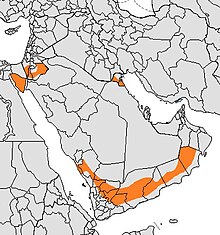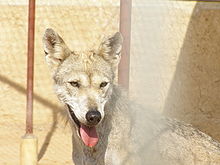|
|
|
This page has archives. Sections older than 360 days may be automatically archived by Lowercase sigmabot III when more than 5 sections are present. |
References[edit]
dog edit[edit]
The domestic dog (Canis lupus familiaris or Canis familiaris)[4] is a member of genus Canis (canines) that forms part of the wolf-like canids,[5] and is the most widely abundant carnivore.[6][7][8] The dog and the extant gray wolf are sister taxa,[9][10][11] with modern wolves not closely related to the wolves that were first domesticated,[10][11] which implies that the direct ancestor of the dog is extinct.[12] The dog was the first domesticated species[11][13] and has been selectively bred over millennia for various behaviors, sensory capabilities, and physical attributes.[14]
bullet[edit]
*bullet *Bullet text
- bullet
aw[edit]
ndbox}}
| Arabian wolf | |
|---|---|

| |
| Scientific classification | |
| Domain: | Eukaryota |
| Kingdom: | Animalia |
| Phylum: | Chordata |
| Class: | Mammalia |
| Order: | Carnivora |
| Family: | Canidae |
| Genus: | Canis |
| Species: | |
| Subspecies: | C. l. arabs
|
| Trinomial name | |
| Canis lupus arabs | |

| |
| Arabian wolf range | |
The Arabian wolf (Canis lupus arabs) is a subspecies of gray wolf which lives on the Arabian peninsula. It is a small, desert adapted wolf that normally lives in small groups and is omnivorous; eating carrion and garbage as well as small to medium-sized prey.[3]
Taxonomy[edit]
The Arabian wolf is designated Canis lupus arabs by the British zoologist Reginald Innes Pocock.[4] Once thought to possibly be C.L. Pallipes (the Indian wolf) the Arabian wolf is now thought to be its own sub-species- C.l. arabs as designated by Pocock in 1934. Pocock noted its smaller skull and smaller size.[5] A new study suggests that genetically the Arabian wolf is closer to C.l. lupus than it is to pallipes. This 2014 study posits that at this point the C.l. arabs subspecies designation should be used.[6] There is admixture with domestic dogs but it is unclear whether this is why it is closer genetically to C.l. lupus.[7] This raises a concern of extinction by hybridization as Arabian wolves are more adapted to desert life than wolf/dog hybrids.[8]
Description[edit]
The Arabian wolf is small for Canis lupus and stands on average 26 inches (66 cm) at shoulder height and weighs an average of 40 pounds (18.14 kg). Along with the Indian wolf, it is probably smaller than other wolves to help it adapt to life in a hot, dry climate. [9] This is an example of Bergmann's rule, where mammal size varies by the warmth of their environment. Its ears are proportionally larger in relation to its body size when compared to other sub-species of Canis lupus, an adaptation probably developed to help disperse body heat.[10] Arabian wolves do not usually live in large packs, and instead hunt in pairs or in groups of about three or four animals.[11] [12]They have a short thin coat which is usually a grayish beige color.[13] "...a mixture of black and slightly buffy grey," according to Pocock in his 1935 description.[14]Like other canines, the Arabian Wolf has no sweat glands - it controls body temperature by rapid panting which causes evaporation from the lungs.[15] It is distinguished from the Indian wolf by its smaller skull and smaller size and thinner coat.[16]

Diet[edit]

Arabian wolves are omnivorous and in some areas largely dependent on human excess products and waste.[17] They also feed on hares, rodents, small ungulates, and carrion. Opportunistically almost any small animal including fish, snails, baby baboons can be part of their diet; they also eat garbage.[18] Arabian wolves hunt small to medium-sized animals such as cape hares, Dorcas gazelles, and ibexes, though they feed on carrion and livestock when in the vicinity of human settlements.[19] Because Arabian wolves can attack and eat any domestic animals up to the size of a goat, Bedouins and farmers will not hesitate to shoot, poison, or trap them.[20]
Range and conservation[edit]
The Arabian wolf was once found throughout the Arabian Peninsula, but now lives only in small pockets in southern Israel,[21] southern and western Iraq, Oman, Yemen, Jordan,[22] Saudi Arabia,[23] and some parts of the Sinai Peninsula in Egypt.[24]
The Arabian wolf is rare throughout most of its range because of human persecution.[25] In Oman wolf populations have increased because of a ban on hunting, and they may naturally re-establish themselves in certain places within the region in the relatively near term.[26] In Israel, between 100 and 150 Arabian wolves are found across the Negev and the Arava. The U.A.E. has a captive breeding program and the wolf is protected in Oman and Israel; but elsewhere its future is uncertain.[27] In Saudi Arabia the wolf is protected in places and still exists in places with sparse human activity.[28]
References[edit]
- ^ a b {{IUCN |assessors=Mech, L.D., Boitani, L. (IUCN SSC Wolf Specialist Group) |year=2010 |id=3746 |title=Canis lupus|version=2011.2}}
- ^ a b Pocock, R.I. (1934). "LXVI.—Preliminary diagnoses of some new races of South Arabian mammals". Journal of Natural History Series 10. 14 (84): 635. doi:10.1080/00222933408654939.
- ^ http://www.jstor.org/stable/1383305?&seq=1#page_scan_tab_contents%7CDOI: 10.2307/1383305
- ^ http://www.tandfonline.com/doi/abs/10.1080/00222933408654939
- ^ http://www.tandfonline.com/doi/abs/10.1080/00222933508654985
- ^ http://www.sciencedirect.com/science/article/pii/S1616504714000603?via%3Dihub
- ^ http://www.sciencedirect.com/science/article/pii/S1616504714000603?via%3Dihub
- ^ http://canids.org/CBC/20/Arabian_wolf_and_domestic_dog_in_saudi_arabia.pdf
- ^ https://books.google.com/books/about/Wolves_of_the_World.html?id=M_q5FP2olaEC PG. 21
- ^ http://onlinelibrary.wiley.com/wol1/doi/10.1111/j.1749-6632.1945.tb36162.x/abstract
- ^ https://books.google.com/books?id=6PTl3wUEJtgC&pg=PA219&lpg=PA219&dq=arabian+wolf+oman&source=bl&ots=iOuJXNjy_v&sig=buo7bp-NlFItWbglBByWj--C3l0&hl=en&sa=X&ved=0ahUKEwioub_y6N7VAhWjjVQKHSB7DTIQ6AEIXzAL#v=onepage&q=arabian&f=false pg 219
- ^ http://www.jstor.org/stable/1383305?&seq=1#page_scan_tab_contents
- ^ http://onlinelibrary.wiley.com/doi/10.1111/j.1096-3642.1935.tb01687.x/abstract PG. 672-673
- ^ http://www.jstor.org/stable/1383305?&seq=1#page_scan_tab_contents
- ^ Harrington & Paquet 1983.
- ^ http://onlinelibrary.wiley.com/doi/10.1111/j.1096-3642.1935.tb01687.x/abstract PG. 672-673
- ^ http://www.jstor.org/stable/1383305?&seq=1#page_scan_tab_contents
- ^ http://nwrc.gov.sa/NWRC_ARB/mzyd_files/1-1994-005.pdf
- ^ Hefner & Geffen 1999.
- ^ http://www.canids.org/canidnews/13/Arabian_wolf_in_Saudi_Arabia.pdf
- ^ http://www.tau.ac.il/~geffene/PDFs/89-Oryx_2013.pdf
- ^ http://journals.tubitak.gov.tr/zoology/issues/zoo-01-25-1/zoo-25-1-3-9909-8.pdf
- ^ http://www.sciencedirect.com/science/article/pii/S1616504714000603?via%3Dihub
- ^ http://www.sciencedirect.com/science/article/pii/S0140196317300174
- ^ https://academic.oup.com/jmammal/article/80/2/611/899899/Group-Size-and-Home-Range-of-the-Arabian-Wolf
- ^ https://books.google.com/books?id=6PTl3wUEJtgC&pg=PA219
- ^ http://www.middleeasteye.net/in-depth/features/conservation-conflict-isis-advancement-and-arabian-wolf-811485183
- ^ http://www.canids.org/canidnews/13/Arabian_wolf_in_Saudi_Arabia.pdf
Citation generator[edit]
- Journal [2]
- Web [3]
- Book [4]
- Google book app http://reftag.appspot.com/
mendelssohn book ref.[edit]
- ^
{{cite journal}}: Empty citation (help) - ^
{{cite journal}}: Empty citation (help) - ^
{{cite web}}: Empty citation (help) - ^ https://books.google.com/books?id=.
{{cite book}}: Missing or empty|title=(help) - ^ Heinrich Mendelssohn; Y. Yom-Tov (1999). Mammalia of Israel. Israel Acedemy of Sciences and Humanities. ISBN 978-965-208-145-2.
